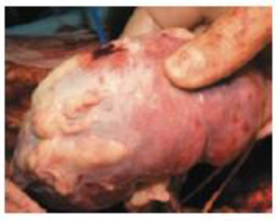
Concept explainers
Since the 1950s, when living kidney donation was first recognized as a viable alternative to cadaver organ donors, family and friends have come forward to offer a kidney to a victim of kidney failure. To reduce the chance that the recipient’s immune system will attack the donated kidney as if it were an invading microbe or parasite, the donor’s blood type and several important glycoproteins should match those of the recipient. But, with the exception of identical twins, no two people have perfectly matching tissues. This means that most people with kidney transplants must take immune-suppressing drugs for the remainder of their lives, making them vulnerable to infections and some types of cancer. Despite this drawback, a transplanted kidney is by far the best option for those lucky enough to receive one.
To remove a donor kidney (FIG. 36-9), surgeons generally use a technique called laparoscopic surgery, where they make half-inch incisions through which they insert surgical tools, including a tiny video camera to guide the operation. The kidney is extracted through an incision about 2½ inches long, put on ice, and rushed to its recipient. The operation takes 3 to 4 hours; donors remain in the hospital for about 3 days and return to work in about 3 weeks. In addition to the risks associated with major surgery, kidney donors will lack a backup kidney in the unlikely event that their remaining kidney fails. But a recent study of deaths among 80,000 kidney donors during a 15-year period found no greater mortality among this group (once they had recovered from their surgery) than among non-donors.

FIGURE 36-9 Surgeons transplant a kidney
Domino donations are almost always started spontaneously by someone inspired to make a difference. Since 2008, when DeGiulio’s donated kidney started a chain that saved four lives (FIG. 36-10), such domino donation chains have become longer and more frequent. For example, during a 4-month period, 17 hospitals in 11 states from California to New Jersey matched 30 people—who might otherwise have died—with kidneys from 30 donors they had never met. This heroic enterprise was started by Good Samaritan Rick Ruzzamenti, who got the idea from the desk clerk at his yoga studio, who had mentioned to him that she had donated a kidney to a friend. “People think it’s so odd that I’m donating a kidney,” he told the transplant coordinator at his hospital, but “I think it’s so odd that they think it’s so odd. . . . It causes a shift in the world.”

FIGURE 36-10 Domino donations Kidneys from compatible strangers saved the lives of these four recipients.
The more than 100,000 eligible individuals awaiting a kidney transplant ardently hope that domino donation chains continue to be forged and to lengthen.
CONSIDER THIS Would you donate a kidney to a friend or family member whose kidneys were failing? Would you consider donating a kidney to a stranger? Explain your reasoning.
Want to see the full answer?
Check out a sample textbook solution
Chapter 36 Solutions
Biology
- Blood Types Are Determined by Cell-Surface Antigens A patient of yours has just undergone shoulder surgery and is experiencing kidney failure for no apparent reason. You check his chart and find that his blood is type B, but he has been mistakenly transfused with type A. Explain why he is experiencing kidney failure.arrow_forwardDescribe the structural differences associated with antigens displayed on the surface of red blood cells. To receive full credit, you have to provide specific descriptions for each blood type and explain the cause of these differences.arrow_forwardWhy does the "rule of three" not applicable to non-normocytic and non-normochromic red blood cells?arrow_forward
- What type(s) of antibodies does the plasma contain for each of the following blood types? (a) type A (b) type B (c) type AB (d) type Oarrow_forwardApart from suffering from recurrent and prolonged infections, Marie Curie also experienced the following signs and symptoms: fatigue, rapid heart rate, pale skin, easy bruising, prolonged bleeding from cuts, and dizziness. Bone marrow transplant was not an option at that time and so blood transfusion was the treatment of choice. Explain the reasoning behind these other signs and symptoms that Curie experienced. Assume her blood group was A negative. Which blood groups can she receive? Which blood groups can she not receive? Explain why.arrow_forwardDescribe three unique characteristics about red blood cells that enable them to perform their job within the body.arrow_forward
- Fill in the blank Hemophilia is a genetic clotting disorder usually characterized by the absence of..........arrow_forwardWhat are the raw materials of anti-aging serum ? Please answer at your own words.arrow_forwardMatch general features of each blood groups in column A with the blood types in column B. contains galactose on erythrocytes cell surface contains N-acetylgalactosamine on erythrocytes cell surface does not contain plasma antibodies recognizing N-acetylgalactosamine and galactose contains plasma antibodies recognizing N-acetylgalactosamine and galactose A. blood type O B. blood type B C. blood type A D. blood type ABarrow_forward
 Human Physiology: From Cells to Systems (MindTap ...BiologyISBN:9781285866932Author:Lauralee SherwoodPublisher:Cengage Learning
Human Physiology: From Cells to Systems (MindTap ...BiologyISBN:9781285866932Author:Lauralee SherwoodPublisher:Cengage Learning Human Biology (MindTap Course List)BiologyISBN:9781305112100Author:Cecie Starr, Beverly McMillanPublisher:Cengage Learning
Human Biology (MindTap Course List)BiologyISBN:9781305112100Author:Cecie Starr, Beverly McMillanPublisher:Cengage Learning Human Heredity: Principles and Issues (MindTap Co...BiologyISBN:9781305251052Author:Michael CummingsPublisher:Cengage Learning
Human Heredity: Principles and Issues (MindTap Co...BiologyISBN:9781305251052Author:Michael CummingsPublisher:Cengage Learning Biology (MindTap Course List)BiologyISBN:9781337392938Author:Eldra Solomon, Charles Martin, Diana W. Martin, Linda R. BergPublisher:Cengage Learning
Biology (MindTap Course List)BiologyISBN:9781337392938Author:Eldra Solomon, Charles Martin, Diana W. Martin, Linda R. BergPublisher:Cengage Learning




